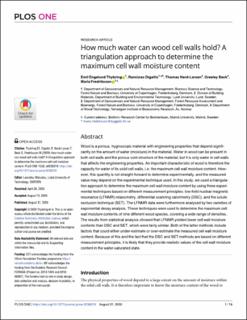| dc.contributor.author | Thybring, Emil Engelund | |
| dc.contributor.author | Digaitis, Ramūnas | |
| dc.contributor.author | Nord-Larsen, Thomas | |
| dc.contributor.author | Beck, Greeley | |
| dc.contributor.author | Fredriksson, Maria | |
| dc.date.accessioned | 2021-01-27T10:18:05Z | |
| dc.date.available | 2021-01-27T10:18:05Z | |
| dc.date.created | 2020-12-23T17:56:46Z | |
| dc.date.issued | 2020-08-31 | |
| dc.identifier.citation | PLOS ONE. 2020, 15 (8), . | en_US |
| dc.identifier.issn | 1932-6203 | |
| dc.identifier.uri | https://hdl.handle.net/11250/2724943 | |
| dc.description.abstract | Wood is a porous, hygroscopic material with engineering properties that depend significantly on the amount of water (moisture) in the material. Water in wood can be present in both cell walls and the porous void-structure of the material, but it is only water in cell walls that affects the engineering properties. An important characteristic of wood is therefore the capacity for water of its solid cell walls, i.e. the maximum cell wall moisture content. However, this quantity is not straight-forward to determine experimentally, and the measured value may depend on the experimental technique used. In this study, we used a triangulation approach to determine the maximum cell wall moisture content by using three experimental techniques based on different measurement principles: low-field nuclear magnetic resonance (LFNMR) relaxometry, differential scanning calorimetry (DSC), and the solute exclusion technique (SET). The LFNMR data were furthermore analysed by two varieties of exponential decay analysis. These techniques were used to determine the maximum cell wall moisture contents of nine different wood species, covering a wide range of densities. The results from statistical analysis showed that LFNMR yielded lower cell wall moisture contents than DSC and SET, which were fairly similar. Both of the latter methods include factors that could either under-estimate or over-estimate the measured cell wall moisture content. Because of this and the fact that the DSC and SET methods are based on different measurement principles, it is likely that they provide realistic values of the cell wall moisture content in the water-saturated state. | en_US |
| dc.language.iso | eng | en_US |
| dc.publisher | PLOS | en_US |
| dc.rights | Navngivelse 4.0 Internasjonal | * |
| dc.rights.uri | http://creativecommons.org/licenses/by/4.0/deed.no | * |
| dc.title | How much water can wood cell walls hold? A triangulation approach to determine the maximum cell wall moisture content | en_US |
| dc.type | Peer reviewed | en_US |
| dc.type | Journal article | en_US |
| dc.description.version | publishedVersion | en_US |
| dc.rights.holder | © 2020 Thybring et al. | en_US |
| dc.source.pagenumber | 18 | en_US |
| dc.source.volume | 15 | en_US |
| dc.source.journal | PLOS ONE | en_US |
| dc.source.issue | 8 | en_US |
| dc.identifier.doi | 10.1371/journal.pone.0238319 | |
| dc.identifier.cristin | 1863126 | |
| cristin.ispublished | true | |
| cristin.fulltext | original | |
| cristin.qualitycode | 1 | |

